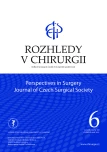The importance of sentinel lymph node biopsy following neoadjuvant chemotherapy in patients with breast cancer: prospective multicentre trial
Authors:
J. Žatecký 1,2,3; O. Kubala 1,4; O. Coufal 2,5; M. Kepičová 4; J. Gatěk 6; J. Prokop 1,4; M. Lerch 3; M. Peteja 1,3
Authors‘ workplace:
Katedra chirurgických oborů, Lékařská fakulta, Ostravská univerzita, Ostrava
1; Klinika operační onkologie, Masarykův onkologický ústav, Brno
2; Chirurgické oddělení, Slezská nemocnice v Opavě, p. o., Opava
3; Chirurgická klinika, Fakultní nemocnice Ostrava, Ostrava
4; Klinika operační onkologie, Lékařská fakulta, Masarykova univerzita, Brno
5; Chirurgické oddělení, EUC Klinika Zlín, Zlín
6
Published in:
Rozhl. Chir., 2021, roč. 100, č. 6, s. 271-276.
Category:
Original articles
doi:
https://doi.org/10.33699/PIS.2021.100.6.271–277
Overview
Introduction: The role of sentinel lymph node biopsy (SLNB) in patients with breast cancer after neoadjuvant chemotherapy (NAC) is currently under discussion. The aim of our study was to determine the false negativity rate (FNR) of SLNB, the accuracy of ultrasound examination in the evaluation of the status of lymph nodes and the accuracy of perioperative cryobiopsy of the sentinel lymph node (SLN).
Methods: Prospective multicentre study, which took place in years 2018−2020 at three centres in the Czech Republic. A total of 59 patients were evaluated.
Results: The FNR of SLNB in the group of patients with cN1 before NAC and ycN0 after NAC was 12.5%. The FNR of perioperative histological examination of the SLN was 38.5%. The FNR of ultrasound examination of axillary lymph nodes in patients after NAC was 35.5%, and the false positivity rate was 16.7%. The incidence of inflammatory complications in our cohort was 3.3%.
Conclusion: The FNR of SLNB in the group of patients with cN1 before NAC and ycN0 after NAC exceeds the tolerable limit of 10%. The FNR of perioperative histological examination of the SLN is high; definitive histological examination of the SLN may change the original diagnostic-therapeutic plan. Ultrasound examination of the axillary lymph nodes in patients after NAC is a method with high false negativity and positivity and may not correspond with the perioperative finding. The incidence of inflammatory complications in our cohort in patients after NAC is comparable to literature data on the frequency of complications in patients without NAC.
Keywords:
breast cancer − sentinel lymph node biopsy − neoadjuvant chemotherapy − axillary dissection
Sources
1. Mansel RE, Fallowfield L, Kissin M, et al. Randomized multicenter trial of sentinel node biopsy versus standard axillary treatment in operable breast cancer: the ALMANAC Trial. Journal of the National Cancer Institute 2006;98(9):599−609.
2. Krag DN, Anderson SJ, Julian TB, et al. Sentinel-lymph-node resection compared with conventional axillary - lymph-node dissection in clinically node-negative patients with breast cancer: overall survival findings from the NSABP B-32 randomised phase 3 trial. The Lancet Oncology [online] 2010;11(10):927−933. doi: 10.1016/ S1470-2045(10)70207-2.
3. Kuehn T, Bauerfeind I, Fehm T, et al. Sentinel - lymph-node biopsy in patients with breast cancer before and after neoadjuvant chemotherapy (SENTINA): a prospective, multicentre cohort study. The Lancet Oncology 2013;14(7):609−618. doi: 10.1016/S1470-2045(13)70166-9.
4. Boughey JC, Suman VJ, Mittendorf EA, et al. Sentinel lymph node surgery after neoadjuvant chemotherapy in patients with node-positive breast cancer: the ACOSOG Z1071 (Alliance) clinical trial. JAMA 2013;310(14):1455−1461. doi:10.1001/jama.2013.278932.
5. Caudle AS, Yang WT, Krishnamurthy S, et al. Improved axillary evaluation following neoadjuvant therapy for patients with node-positive breast cancer using selective evaluation of clipped nodes: Implementation of targeted axillary dissection. Journal of Clinical Oncology [online] 2016;34(10):1072−1078. doi: 10.1200/ JCO.2015.64.0094.
6. Liu LC, Lang JE, Lu Y, et al. Intraoperative frozen section analysis of sentinel lymph nodes in breast cancer patients: a meta - analysis and single-institution experience. Cancer 2011; 117(2):250−258. doi: 10.1002/cncr.25606.
7. Wyld L, Markopoulos C, Leidenius M, et al. Breast cancer management for surgeons: A European multidisciplinary textbook. B.m.: Springer International Publishing 2018.
8. Wong J, Yong WS, Thike AA, et al. False negative rate for intraoperative sentinel lymph node frozen section in patients with breast cancer: a retrospective analysis of patients in a single Asian institution. Journal of Clinical Pathology 2015;68(7):536−540. doi: 10.1136/jclinpath - 2014-202799.
9. Godazande G, Moradi S, Naghshvar F, et al. Is necessary intraoprative frozen section in sentinel lymph node biopsy for breast cancer patients? Asian Pacific Journal of Cancer Prevention [online]. 2020, 21(3):647−665.
10. Almarzooq R, Alrayes A, Saeed A, et al. Accuracy of intraoperative frozen section evaluation of sentinel lymph node biopsy in breast cancer: Our experience in Bahrain. The Gulf Journal of Oncology 2018;1(28):46−51.
11. Coufal O, Zapletal O, Gabrielová L, et al. Cílená axilární disekce a sentinelová biopsie u pacientek s karcinomem prsu po neoadjuvantní chemoterapii − retrospektivní studie. Rozhledy v chirurgii 2018;97(12):551−557.
12. Hieken TJ, Boughey JC, Jones KN, et al. Imaging response and residual metastatic axillary lymph node disease after neoadjuvant chemotherapy for primary breast cancer. Annals of Surgical Oncology [online] 2013;20(10):3199−3204. doi: 10.1245/ s10434-013-3118-z.
13. Bowen ME, Mone MC, Buys SS, et al. Surgical outcomes for mastectomy patients receiving neoadjuvant chemotherapy: A propensity-matched analysis. Annals of Surgery 2017;265(3):448−456. doi: 10.1097/SLA.0000000000001804.
14. Xue DQ, Quian C, Yang L, et al. Risk factors for surgical site infections after breast surgery: a systematic review and meta-analysis. European Journal of Surgical Oncology 2012;38(5):375−381. doi: 10.1016/j.ejso.2012.02.179.
Labels
Surgery Orthopaedics Trauma surgeryArticle was published in
Perspectives in Surgery

2021 Issue 6
Most read in this issue
- Iodine seed localisation of non-palpable lesions in breast surgery − first experience
- Appendiceal mucocele – a radiologist’s view
- Phyllodes tumor and its malignization into invasive ductal carcinoma − a case report
- Aneurysm of pancreaticoduodenal arcade caused by medial arcuate ligament syndrome – case report and review of literature
